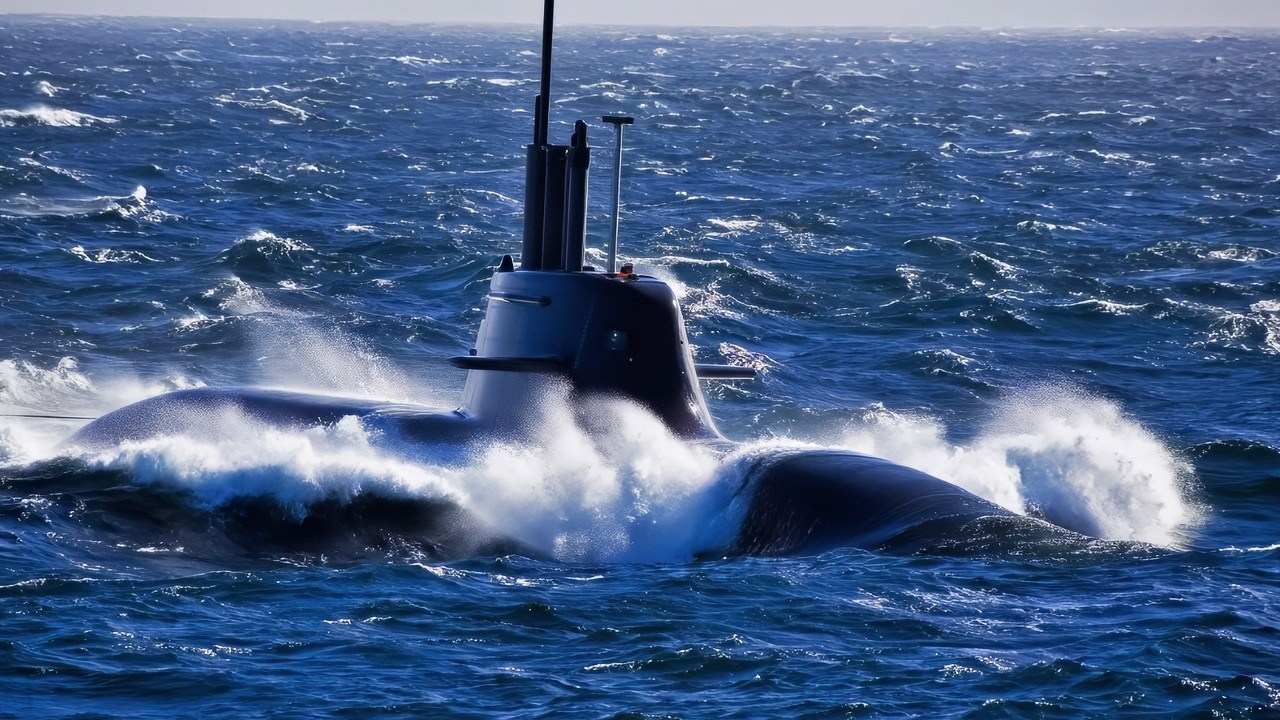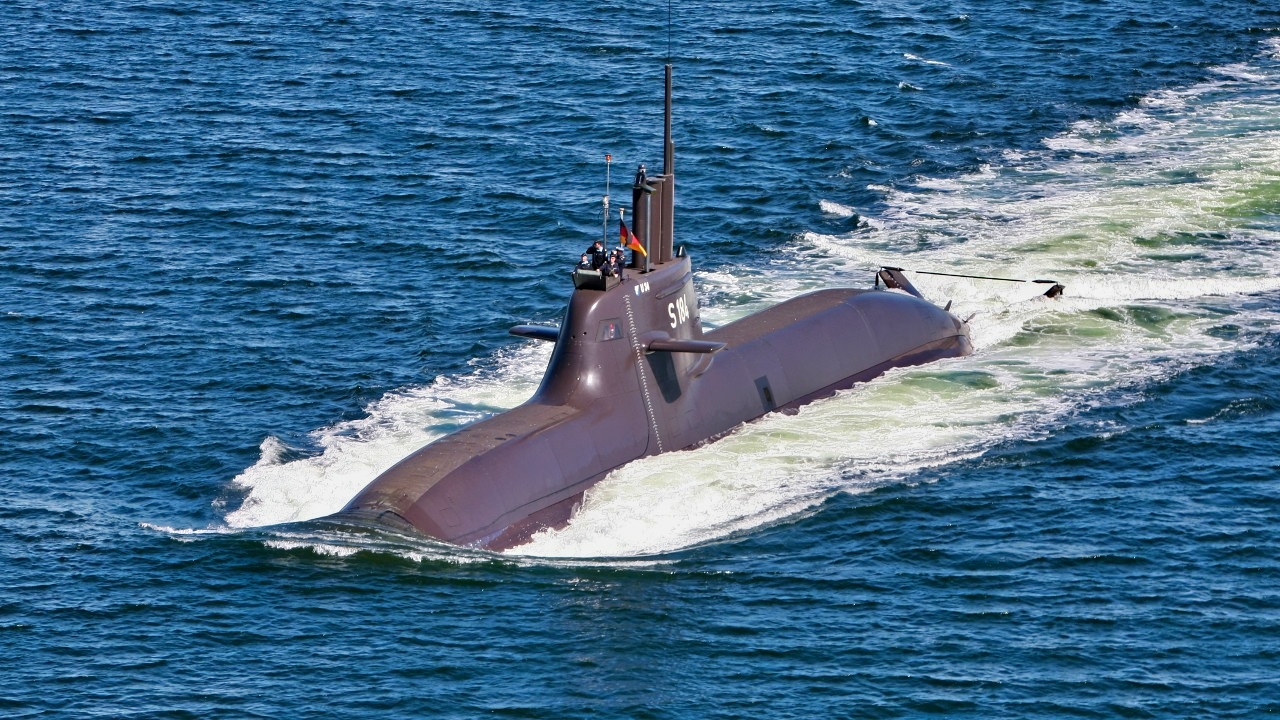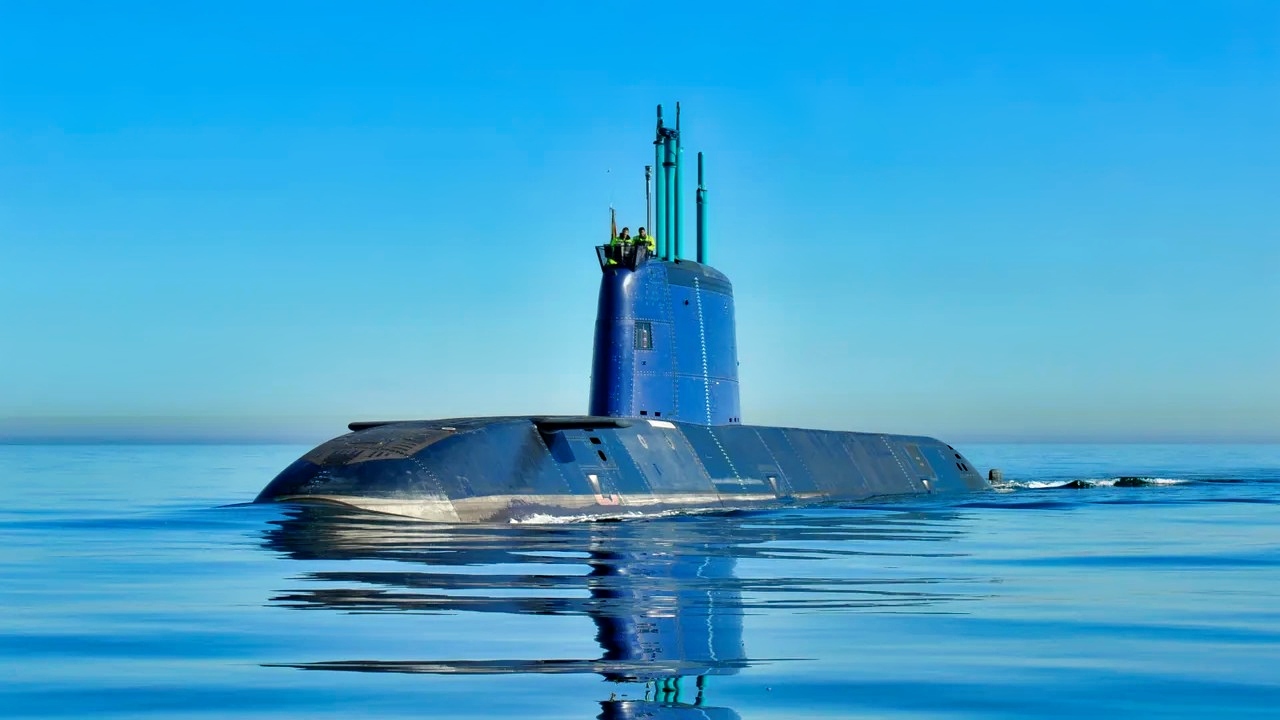Key Points and Summary – Israel’s German-built Dolphin-class submarines were conceived after the Cold War to give Jerusalem a survivable strike option and unmatched undersea reach.
-The first three boats emphasized quiet conventional operations; the follow-on “Dolphin II” added air-independent propulsion for weeks-long submergence, enlarged torpedo tubes, and Israeli combat systems.

Dolphin-Class Submarine. Image Credit: Creative Commons.
-Costs rose as capability grew, and a new Dakar-class is now queued to replace the earliest hulls.
-Officially, their mission is intelligence, special operations, and long-range conventional strike.
-Practically, their design choices—especially the oversized tubes and long endurance—fit a classic second-strike profile.
-In a region of missile salvos and hardened sites, that logic is hard to miss.
The Dolphin-Class Submarines Explained
Israel’s submarine story is not about prestige—it’s about survival.
After the 1991 Gulf War and repeated missile attacks on cities, Israeli defense planners re-examined the worst case: a large-scale strike that might overwhelm missile defenses and land-based airfields. The question wasn’t whether Israel could retaliate; it was whether any retaliatory capability would survive the opening blow. That drives you to the sea. Submarines move, hide, and wait. They give politicians time and options when hours matter.
Germany’s post–Cold War shipyards had the right tooling, design heritage, and—after a wrenching debate—the political will to help. Out of that compromise emerged the Dolphin: a custom evolution of proven German diesel-electric design, built for Israel’s geography and anxieties.

Type 212 German Submarine. Image Credit: German Navy.

Type 212A. Image Credit: Creative Commons.
From First Dolphins To “Dolphin II”: What Changed And Why
The first trio—Dolphin, Leviathan, Tekuma—entered service around the turn of the millennium. They were meticulously quiet diesel-electric boats with advanced Israeli combat systems and a mix of standard 533-millimeter torpedo tubes and four enlarged tubes. Those larger tubes, atypical for boats this size, immediately fueled speculation: special operations gear? Encapsulated long-range missiles? Both are plausible, and both fit Israel’s needs.
The second batch—often called Dolphin II—arrived with a decisive upgrade: air-independent propulsion (AIP) based on fuel cells. AIP changes the calendar of war at sea. Traditional diesel-electrics must snorkel periodically to recharge batteries, risking detection.

Yuan-Class Submarine AIP. Image Credit: Creative Commons.
AIP boats can loiter submerged for weeks, making them much harder to find and far better suited for distant patrol areas and time-sensitive missions. The follow-on hulls also gained improved masts, optronics, sonars, and Israeli electronic warfare, all integrated into a digital combat system that plays well with national intelligence networks.
A third wave is now in the pipeline: the Dakar-class. These successor boats will replace the earliest Dolphins in the 2030s, carrying forward the same logic—greater endurance, better sensors, and more room for Israeli mission kits—on a fresh hull form.
What The Design Tells You (Even When Officials Won’t)
You can learn a lot from shapes and spaces.
The Dolphin’s enlarged forward tubes are not a cosmetic flourish. They allow launch of bulky special-mission payloads or nuclear-armed long-range cruise missiles that wouldn’t fit through standard tubes. In parallel, the boats’ internal layout leaves volume for additional fuel, batteries, and mission electronics—choices you make if you expect to wait a long time in a patrol box and then reach far inland.
Quieting is the other giveaway. These subs are tuned for discretion first: rafted machinery, careful hull coatings, precise propeller work, and the ability to shut down to near-silent drift. Add AIP and the boat becomes a patient hunter—or a patient sentinel—rather than a sprinter. That is the profile of a platform meant to be present, undetected, when worst-case decisions are on the table.
What It Cost—And Why The Price Climbed
The opening act was politically subsidized. Germany absorbed much of the bill for the initial boats, a choice rooted in both industrial policy and history. As the design grew more bespoke—and as AIP, Israeli combat systems, and deeper changes arrived—the unit cost rose into the high hundreds of millions per boat, edging toward (and in later cases exceeding) the billion-dollar line depending on configuration and support packages.
Sticker shock is real, but context matters. Submarines are not consumables; they are 30-year instruments. When a platform underwrites nuclear-scale deterrence and daily intelligence work, governments will accept a higher price to avoid technological dead ends or vendor lock-in that constrains mission growth.
How The Boats Have Been Upgraded In The Wild
Israel rarely advertises specific refits, but patterns are clear. Sensors cycle forward—new towed arrays, quieter processing, better periscopes with infrared and low-light cameras. Combat systems migrate toward open architectures so Israel can insert homegrown software, electronic-warfare tricks, and secure data links on its own timetable. Masts get better radios and satellite communications. Crew-comfort improvements may seem trivial, but they matter on multi-week patrols where fatigue is as lethal as depth charges.
The most eye-catching change on at least one later boat is an elongated sail—a visual hint of extra internal volume for special mission equipment. Whether that space hosts unmanned vehicles, novel communications, or something more kinetic, the message is the same: the Dolphin family is a living design, not a frozen museum piece.
The Stated Mission: Intelligence, Special Operations, Conventional Strike
Ask Israeli officials what the Dolphins do and you get the safe answer: they gather intelligence, insert specialized teams, and hold conventional targets at risk from standoff range. All of that is true. Submarines are exquisite listening posts. They can sit beneath shipping lanes, coastlines, or cable routes and collect. They can put small teams ashore where aircraft are too risky. And with modern sea-launched cruise missiles, they can strike fixed targets without warning.
Those missions alone justify the class. But they are also the perfect cover for a more consequential role.
Why A Sea-Based Nuclear Option Is The Logical Conclusion
Israel practices “amimut,” deliberate ambiguity about nuclear matters. No confirmations, no denials, no chest-thumping. Even so, the logic chain is short:
Second-strike necessity. If an enemy believes it can disarm your land-based forces and airfields in a first blow, deterrence erodes. A submarine at sea, on an unpredictable patrol line, restores uncertainty to an adversary’s calculus.
Design fingerprints. Oversized tubes, long endurance, quieting, and precision navigation are exactly what you build if you intend to carry a handful of long-range, sea-launched missiles that can be fitted with special warheads.
Open-source reporting. For decades, reputable outlets and independent analysts have described Israeli work on long-range submarine-launched cruise missiles and at-sea trials consistent with such capabilities. The details vary; the thrust does not.
Doctrine fit. Israel emphasizes deterrence without disclosure. A survivable, sea-based backstop fits that doctrine like a glove: there’s no parade, no basing controversy, and no daily signal—just the knowledge among serious actors that options exist if the absolute worst occurs.
No single fact “proves” a nuclear role, and none will—by design. But if you follow the money, the engineering, and the strategic incentives, the conclusion that Dolphins form a credible sea-based leg of Israel’s deterrent is hard to avoid.
Geography Is Destiny: Where Dolphins Matter Most
Look at a map. From Haifa or other Israeli ports, a Dolphin can reach the Eastern Mediterranean in hours, the Red Sea via Suez, and the Arabian Sea with smart logistics. AIP stretches those timelines in Israel’s favor. That routing places potential adversaries’ critical nodes—air bases, command centers, missile fields, and power infrastructure—within reach of standoff weapons, all without the visibility and overflight headaches of a large air package.
That same geography pays daily dividends in peacetime: watching shipping, eavesdropping near chokepoints, and tracking regional naval movements. If deterrence is a story you tell your adversaries quietly, Dolphins give Israel a voice the other side can hear, even if the public cannot.
The Politics Behind The Steel
Buying submarines is as much about political stamina as it is about metallurgy. The Dolphin program has had its controversies—heated parliamentary arguments in Berlin and Jerusalem about subsidies, timing, and ethics. None of that changes the strategic rationale or the engineering truth: Israel’s defense community stuck with the program across decades because the boats solve a problem nothing else does.
They are also a diplomatic bridge. Germany’s sustained role created a long-term defense-industrial bond that has proven remarkably resilient, even when other issues grew tense. In a volatile region, that steady supply chain is part of the deterrent.
What Comes Next: Dakar And The Long Game
The coming Dakar-class will not be a revolution so much as a matured answer to the same exam: longer legs, more efficient electric drive, deeper integration of Israeli sensors and software, and enough space and power for whatever payloads the 2030s demand—manned, unmanned, kinetic, and informational. Expect more automation (to ease crew burden), quieter everything (to stay ahead of proliferating sensors), and still-tighter coupling with national intelligence and strike networks.
Crucially, replacing the earliest Dolphins on a one-for-one basis keeps the deterrent at sea without gaps. The point of a second-strike capability is not to surge in crisis; it is to exist every day, even when headlines go quiet.
The Strategic Payoff—And The Price Of Getting It Wrong
A capable submarine force buys a country time, and time is oxygen in a crisis. It denies an adversary the fantasy of a clean first strike. It gives leaders options that aren’t binary. And because submarines are hard to count and harder to find, it forces caution on planners who might otherwise gamble.
The price of underinvesting is the opposite: brittle deterrence and escalatory pressure to “use or lose” vulnerable land-based assets. Israel’s bet on quiet endurance—and the ability to hold distant targets at risk from offshore—pushes that risk back where it belongs: on anyone tempted to miscalculate.
Bottom Line on the Dolphin-Class
Israel’s Dolphin-class submarines began as a practical answer to practical fears: survive the opening punches of a regional war, maintain credible reach, and keep options alive for the government if the unthinkable happens.
The hardware tells the story—enlarged tubes, weeks-long submergence, meticulous quieting, Israeli brains in the combat system, and a steady march toward more endurance and flexibility.
Officially, they are conventional multi-mission boats. Strategically, they look exactly like the sea-based insurance policy a nuclear-ambiguous state would build. That is the point. In deterrence, what you might do is as powerful as what you say. The Dolphins are the “might” that matters.
About the Author: Harry J. Kazianis
Harry J. Kazianis (@Grecianformula) is Editor-In-Chief and President of National Security Journal. He was the former Senior Director of National Security Affairs at the Center for the National Interest (CFTNI), a foreign policy think tank founded by Richard Nixon based in Washington, DC. Harry has over a decade of experience in think tanks and national security publishing. His ideas have been published in the NY Times, The Washington Post, The Wall Street Journal, CNN, and many other outlets worldwide. He has held positions at CSIS, the Heritage Foundation, the University of Nottingham, and several other institutions related to national security research and studies. He is the former Executive Editor of the National Interest and the Diplomat. He holds a Master’s degree focusing on international affairs from Harvard University.
More Military
Why the U.S. Navy Finally Said No to the F-14 Tomcat
China’s ‘New’ J-35A Air Force Stealth Fighter Suffers From 1 Big Disadvantage
China’s Stealth Submarine Fleet Has a Message for the U.S. Navy
The U.S. Army’s Drone Nightmare Is Coming True
Mach 6 ‘Miracle’ SR-72 Darkstar Has a Message for Russia or China










